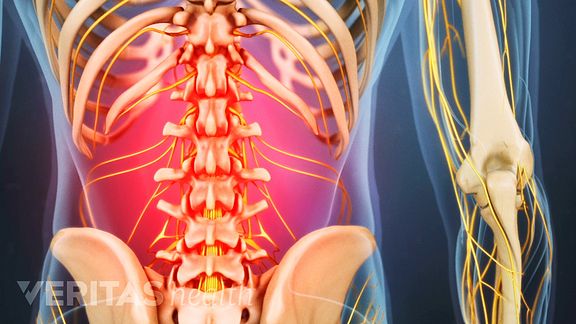Muscle spasms in your back can range from a minor discomfort and stiffness to a sharp, severe pain and muscle tightening that prevents normal back movements. Your back might be telling you to avoid a certain activity, or it could be warning of a more serious underlying issue in your spine.
A muscle strain can be a source of extraordinary pain. Watch: Lower Back Strain Video
Causes of muscle spasm
The first step to understanding what your back muscle spasm is telling you is to visit a doctor and get an accurate diagnosis. In general, most back muscle spasms occur because of the following reasons:
- The muscles are trying to protect themselves from muscle strain
A back spasm can occur after any type of strain or injury to the soft tissues (muscles, tendons or ligaments) in the spine. This type of soft tissue injury typically heals enough within a week or two for the muscle spasms to stop. - The muscles can spasm in response to an underlying anatomical problem
If your back spasm does not get better in 1 to 2 weeks, or it comes and goes over time in the same area of your back, you may have an underlying anatomical problem in your spine. Some examples of underlying issues that could cause your back to spasm include:
When these or other underlying anatomical problems are present in the spine, muscle spasms are likely to keep recurring due to ongoing inflammation or instability. It is important to seek medical attention to treat the underlying cause of your symptoms, rather than just treating the symptoms.
Watch Video: What Is Your Back Muscle Spasm Telling You?
First aid for a painful back muscle spasm
When your back goes into spasm, the initial treatment goal is to get the muscle to relax and thus relieve the pain. Some effective treatments include:
Short period of rest
A painful back muscle spasm can make it difficult to perform daily activities or even move. Pushing through the pain may lead to further injury and delay recovery. Rather than trying to push through the pain, give it a rest. For example, stay home for the day and take it easy. Just remember to move as tolerated, such as by going for short walks. Prolonged inactivity can stiffen your muscles and lead to more pain. In general, walking is gentle on your back and promotes blood flow, which in turn helps speed the healing process. However, in some cases uneven ground or walking down or uphill can exacerbate an underlying reason for the muscle spasms. If that occurs, pay close attention to what aspect aggravates the symptoms and try to avoid it if possible.
Cold therapy
Applying ice wrapped in a protective sheath or towel, or a cold pack, to the painful part of your back is another way to help relieve an acute flare up of pain. As a general guideline, cold therapy will help reduce local inflammation, which in turn contributes to relieving pain. You can use a commercial ice pack or make one yourself. Cold therapy can be applied for 15 or 20 minutes, then give the skin a rest for a couple hours before the next application.
Watch: Video: How to Make a Gel Ice Pack
In This Article:
- What Is Your Back Muscle Spasm Telling You?
- Understanding Lower Back Strain
- First Aid for Intense Pain from a Pulled Lower Back Muscle
- Video: What Is Your Back Muscle Spasm Telling You?
Heat therapy
Applying a heat pack or heating pad to the affected area can bring increased blood flow and soothing pain relief. As with cold therapy, limit applications of heat therapy to 15 or 20 minutes at a time. Allow for at least a couple hours of recovery time for your skin between applications. If using a commercial heat pad, follow its direction carefully.
See Benefits of Heat Therapy for Lower Back Pain
Comfortable inclined position
When you rest, you can reduce stress on your lower back by laying on your back in bed with your upper body supported at a slight incline and a pillow propped under your knees. Also, try sitting at an incline in a reclining chair with your legs supported and knees slightly bent.
Over-the-counter pain relievers
A nonsteroidal anti-inflammatory medication (NSAID) can help reduce inflammation and pain. Examples of over-the-counter NSAIDs include ibuprofen (Advil, Motrin), naproxen (Aleve), and aspirin. Some people find that acetaminophen (Tylenol), which addresses pain but not the inflammation, is effective. Read and follow medication labels carefully before use.
See Common NSAIDs for Back and Neck Pain
Muscle relaxants
These are prescription medications that do not directly target the muscles; rather, they have an overall relaxing effect on your body. Muscle relaxants are typically only prescribed if the pain is intense, believed to be stemming from the muscle spasm (at least in part), and other treatments (such as described above) have not provided enough relief. Due to the risk of serious side effects, muscle relaxants are only used on a short-term basis. Some side effects may include dizziness, sleepiness, reduced reaction time, and others. Driving is not permitted while under the influence of muscle relaxants.
See Side Effects and Risks of Muscle Relaxers
After the acute pain of your back muscle spasm has resolved, your doctor or physical therapist may suggest physical therapy. A controlled, progressive exercise program that is tailored to fit your needs may help reduce or avoid future flareups of back pain.
See Strengthening Exercise Program for Low Back Pain Relief

